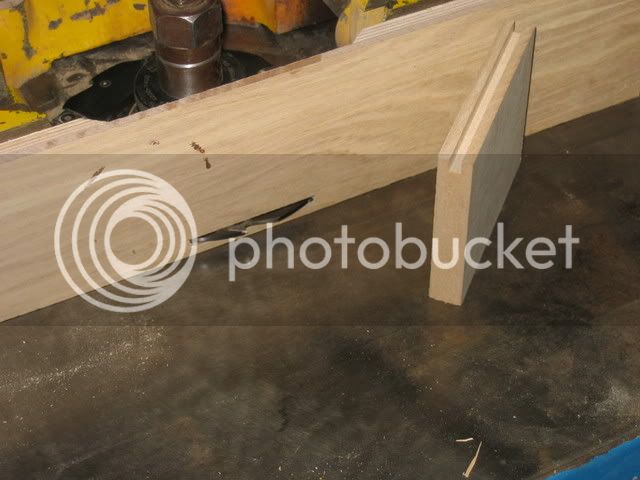Anyway - tooling. For anyone who's never seen one here's a limiter cutter block set-up with a pair of profile cutters and limiters:
The black knives are the limiters. This is one of the smaller blocks with a 100mm cutting circle and 40mm high knives. The knives/limiters are located on two pins and held in place by wedges making it highly unlikely to drop a cutter, even if the screws do come loose. Despite the APTC marked on it it is actually a modern Whitehill block
Grooving I do with "dial-a-width" groovers like this Stark one:
Rhese have a groove height range a little under 2:1 and make adjustng a groove to the right width really easy - and much quicker than using a shimmed cutter set. In use you'd typically see no more than this amount of projection (through a secrificial fence):
The false fence is added to give more support to the workpiece and stop it dropping into a rather large gap between the fence pieces. This is what the gap looks like after fitting modified fence plates (but without the sacrificial fence):
For rebates I tend to use blocks such as this one:
A skew-cutter TCT-RT block. This one can additionally hold small profile cutters to add drip grooves, etc. Note the spurs. This cutter was used to work a large rebate in one pass (a wee bit off square because we were using RS stock

). Much bigger cut than you'd normally achieve with a router in a single pass (sorry about the naff picture quality and thank you Brad for modelling this wonderful piece of modern sculpture):
Finally, for a bit of a larf we set-up the vari-angle chamfer block so it thought it was a panel raiser (here shown set-up for working from the underside of the panel - my preferred approach):
Unfortunately the recess in the top of the machine proved too small to allow me to drop the cutter below the surface, so it was necessary the set it up the work above the panel, a much less safe alternative (better to set-up a false bed so that the workpiece vcan be run above the cutter - as Brad I'nm sure will agree). Here's the (not very good, although it was a 2 minute hurry-it up set-up) sample:
And for anyone interested good spindle moul;der tooling doesn't come cheap - this set of four cutters would run you £700 to £900 approximately, with the Vari-Chamfer the most expensive at about £300 + VAT
Thanks to "Brad Naylor" for allowing me to publish these photos taken in his shop, hopefully the stains will come out in the wash :lol: :wink:
Scrit




















































